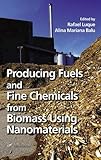Producing fuels and fine chemicals from biomass using nanomaterials / edited by Rafael Luque, Alina Mariana Balu.
Material type: TextPublisher: Boca Raton : CRC Press, [2014]Copyright date: �201Description: 1 online resource : text file, PDContent type:
TextPublisher: Boca Raton : CRC Press, [2014]Copyright date: �201Description: 1 online resource : text file, PDContent type: - text
- computer
- online resource
- 9781466553408 (ebook : PDF)
- Also available in print format
Includes bibliographical references and index
section I. Nanomaterials for energy storage and conversion -- section II. Biofuels from biomass valorization using nanomaterials -- section III. Production of high-added-value chemicals from biomass using nanomaterials
"This book explores the available technologies for the preparation of fuels and chemicals from biomass using nanomaterials. This focus bridges the gap between three hot topics: nanomaterials, energy, and the environment. The book also deals with other important topics related to nanomaterials including toxicity and sustainability and environmental aspects. "-- Provided by publisher
"Preface The design of novel and innovative methodologies to maximize current available reources without compromising the future of coming generations is one of the most important challenges of the 21st century. The scarcity of resources and the expected increase in population and energy demands are two of the most important issues to be addressed. In this regard, green chemical and low-environmental-impact technologies combined with renewable resources through innovation will be able to offer alternatives to potentially useful processes for a more sustainable bio-based society in which we will move away from the petrol-based economy we have relied upon the past 50-plus years. Biomass is one of the most promising and widely available renewable feedstocks that has a significant potential to offer a number of alternatives to be converted to materials, fuels and chemicals. Waste residues can also partially help contributing to this aim, leading to advance valorization technologies for energy and fuels production. On the other hand, nanotechnology and nanomaterials development have experienced a staggering evolution in recent decades to the point that scientists are currently able to design and optimize a surprisingly significant number of nanomaterials for an extensive range of applications including energy storage, fuels production, biomedicine, and nanocatalysis, which are also taken to industrial and commercial practices. Combining the design of nanomaterials for the valorization of biomass and waste feedstocks to energy and chemicals as well as to (solar) energy storage can constitute a major step forward to further advancing current society in a scientific understanding of properties and alternative applications of nanomaterials in our goal toward a sustainable future"-- Provided by publisher
Also available in print format
There are no comments on this title.


